Japanese Burials at Ross Bay Cemetery
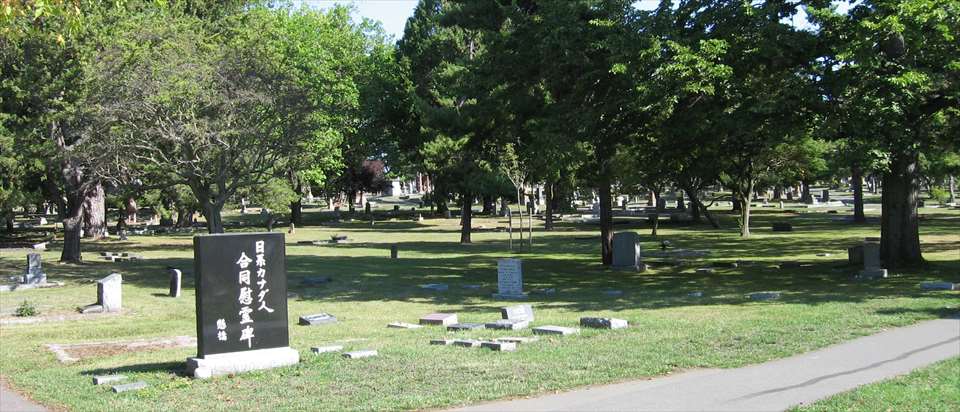
Summary
At the southern end of the city of Victoria, BC, Canada, facing Ross Bay, is Ross Bay Cemetery where 153 early Japanese immigrants, including 56 children, rest. The grave markers, which were severely damaged by the war and disasters, were reconstructed and reorganized in the 1990s by the “Pacific-Ocean Kake-Hashi group” of Japanese and Japanese-Canadian volunteers (“Kake-Hashi” means “bridge”), and a memorial monument was built there. This website holds a catalogue of buried Japanese immigrants, including their names, ages at death, dates of death (burial), as well as the photos of their grave markers.
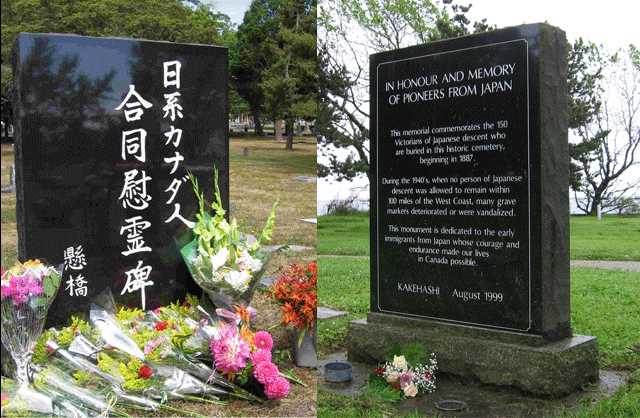
History
In this section, we would like to let you know the history of the Ross Bay Cemetery grave sites of the Japanese pioneers of Victoria, as well as their children. These early Japanese people migrated to Victoria between the 1880s to the 1920s.
In the latter half of 1880s, the migration of Japanese people to Canada increased notably and, since in those days, there was no well-equipped port in Vancouver, the immigrants from Japan landed at Victoria. Japanese immigrants were employed mainly in the fishery, in the forestry/lumber industry or as coal mine labourers. Due to the low-wages and harsh work conditions as well as the poor quality of available nutrition and medical services, a lot of early Japanese-Canadians died young. The mortality rate of infants and young children in the Japanese community was also quite high.
When they died, members of Victoria’s early Japanese community were buried, like many other pioneers, in Ross Bay Cemetery. Because of the strongly held prejudicial racial attitudes of those days, white Caucasians were buried in the central area of the graveyard, but Japanese and Chinese people were only allowed to be buried in the southernmost part of the cemetery close to the shore of Ross Bay.
When the Pacific theatre of WW II opened up in 1941, Japan became one of Canada’s enemy nations, joining the other members of the WW II Axis. The government of Prime Minister William Lyon McKenzie King took the attitude that all those of Japanese heritage in Canada were now essentially enemy aliens. As a result, those Japanese in Canada who resided near the Pacific coast were forced to move to the interior or eastern part of the country by the Canadian government’s relocation plan and they were imprisoned in detention camps.
Because all those of Japanese heritage who lived in Victoria were forced to move, including second and third generation Japanese-Canadians, no family members such as a spouse, parent, child, brother or sister of Japanese people buried in the Ross Bay Cemetery could remain in Victoria. To make it even more miserable for the detainees, all the property of the Japanese who were forced to leave was confiscated by the government and this was a major contributing factor to none of them returning to Victoria after the war.
After the war, no Japanese community was left in Victoria which could take care of the graves of those who had passed away. Furthermore, a large number of grave posts and ashes of Japanese people buried along the seashore were shifted by erosion due to heavy storm waves. Hence, in the decades following the war, most of the graves of Japanese pioneers were damaged, and their original positions in the graveyard became unclear.
After the war, the Japanese graves in Ross Bay Cemetery faded from people’s memory until the 1990s, when a few Japanese immigrants and Nikkei Nisei (second generation) who moved to Victoria after the war realized that there were, indeed, some Japanese graves at Ross Bay. Volunteers who were deeply saddened by the atrocious condition of the graves of Japanese pioneers in Ross Bay Cemetery eventually came together to establish the Kake-Hashi Society and started to make a list of the Japanese people buried in the cemetery, as well as to restore and reorganize the gravestones.
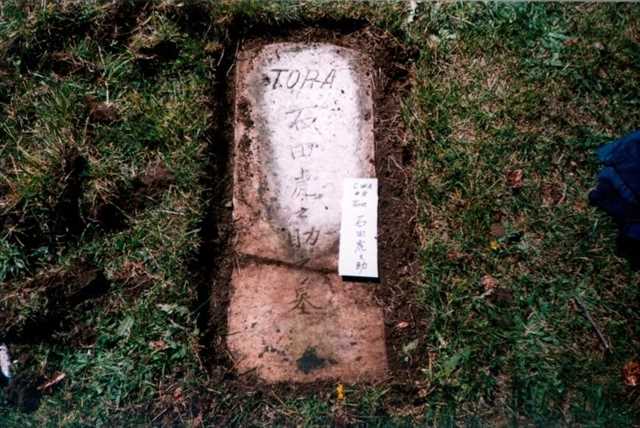
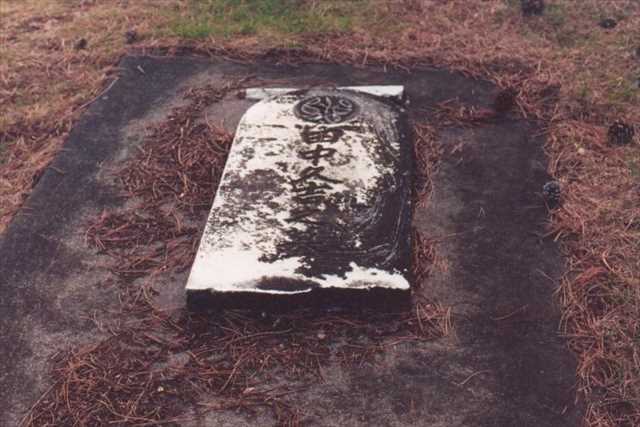
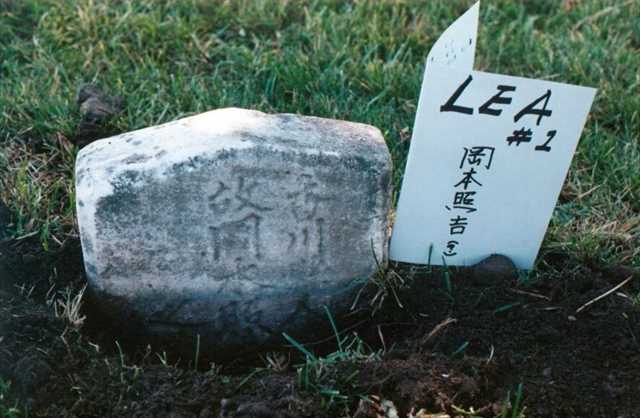
Owing to the dedicated volunteer efforts of the Kake-Hashi Society, the locations of most of the Japanese graves have been ascertained, and gravestones have been restored to their original positions. However, since the grave register book of the Ross Bay Cemetery is written in English, some records do not correctly reflect Japanese names. Therefore, investigation of those people of Japanese heritage buried in Ross Bay Cemetery and the restoration and reorganization of gravestones is still on-going.
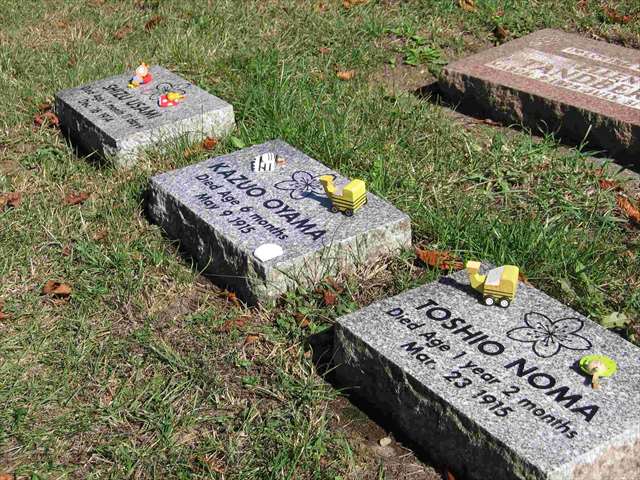
Detailed Analysis and Discussion
The history of the Japanese immigrants in Canada as well as the features of the Japanese graves in Ross Bay Cemetery are analyzed and discussed in more detail in the following articles posted in this website, which are currently available in Japanese version only:
“ロスベイ霊園の日本人墓地:歴史の縮図 Part I (Japanese Burials at Ross Bay Cemetery: Facts and Features, Part I)”
“ロスベイ霊園の日本人墓地:歴史の縮図 Part II (Japanese Burials at Ross Bay Cemetery: Facts and Features, Part II)”
“ロスベイ霊園の日本人墓地:歴史の縮図 Part III (Japanese Burials at Ross Bay Cemetery: Facts and Features, Part III)”
Grave List and Photos
We carried on continued field researches at the site and confirmed the places of all the graves of those Japanese people buried in Ross Bay Cemetery, ascertained so far. The grave list as well as the photos of all the existing gravestones have been uploaded in this website.
If you or your friends have an ancestor or a relative who immigrated to Canada from the 1880s to the 1920s (during the Meiji and Taisho eras in Japan), please take the opportunity to review the name list carefully. If you find a name which may be your or your friend’s ancestor or relative, please look at the photo of the gravestone and think contemplatively of that person, praying for peaceful rest for his or her soul.
The grave list includes names, ages, death or burial dates, etc. of the Japanese pioneer immigrants, ascertained so far. The list and photo catalogues of the grave markers are downloadable in the following page of this website:
“Japanese Burials at Ross Bay Cemetery: Grave List and Photos”
Obon Memorial Ceremony
Victoria’s Japanese pioneers are further memorialized every summer. In order to pray for the peace and repose of the souls of all the Japanese pioneer immigrants of Victoria, an Obon memorial ceremony is held every year by the Nikkei (both first, and subsequent generation, Japanese- Canadian) community, the ceremony being currently organized by the Victoria Nikkei Cultural Society (VNCS). For more details of the Obon ceremony, visit the following website of VNCS.
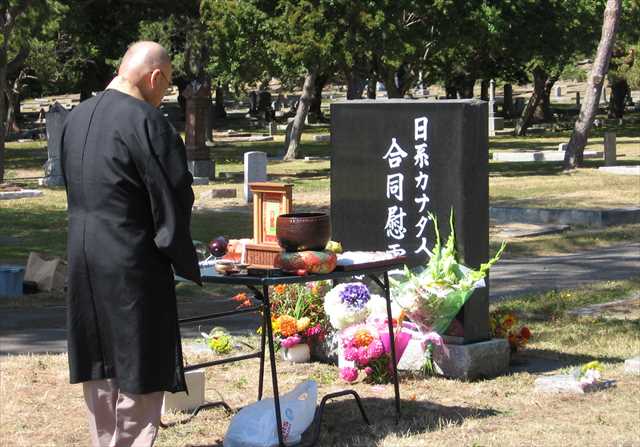
Japanese Canadian Community Organization of Victoria
A research-based non-profit society for the highest standards of multiculturalism